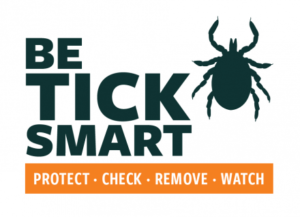It’s a fact. Ticks are in our woods and fields. And, we love to be outdoors, maybe we even earn our living in the outdoors. Learning to be Tick Smart is the best course of action to protect yourself and your family members.
Tick Smart has four basic tenets: Protect. Check. Remove. Watch.
Protect
- Use an EPA-approved tick repellent on skin
- Apply permethrin to clothing
- Wear long pants, light colored to see ticks, tuck pant legs into socks; wear long-sleeved shirts.
Check
- Check your clothing before going indoors, toss in the dryer on high heat for 10 minutes
- Shower within a few hours of being outdoors and check your entire body for ticks
Remove
- Use tweezers to grab tick close to skin and pull straight up (do not twist)
- Wash hands and bite area with soap and water
- Do NOT handle the tick with your bare hands
Watch
- Watch for symptoms of tickborne diseases, such as fever, muscle aches, fatigue and joint pain
- Contact your health care provider should any symptoms appear
See the CDC website for tick removal and testing information
Lyme Disease and Other Tickborne Illnesses
There are 14 known species of ticks in Vermont. The blacklegged tick (Ixodes scapularis), more commonly known as the deer tick, is the abundant in Vermont. The blacklegged tick is responsible for over 99% of all tick-borne diseases reported to the Vermont Department of Health. most These ticks can transmit Lyme disease, anaplasmosis, babesiosis, Borrelia miyamoitoi disease, and Powassan virus disease.
Many of us know at least one person with Lyme or other tickborne illness. Learn to recognize the signs and symptoms to help protect yourself and be proactive with your health care provider. The first sign of Lyme disease is often an expanding red rash at the site of the tick bite. The rash usually appears seven to fourteen days after the bite, but sometimes takes up to thirty days to appear. Not everyone gets the rash. In fact about 30% of confirmed cases did not have a rash. So, be on the lookout for flu-like symptoms of early Lyme disease: fatigue, headache, fever, chills, swollen lymph nodes, muscle and joint pain. Lyme disease can be successfully treated with antibiotics, especially if detected early.
The Vermont Tick Tracker is a crowd-sourced tool that allows anyone to contribute to our understanding of ticks in Vermont. The tool enables users to report tick bites, identify species, and see where other tick bites have occurred in the state. The more reports posted by users, the better the information the tracker can provide. You can also visit the Health Department’s website that offers extensive information about ticks and tickborne disease prevention and treatment.



